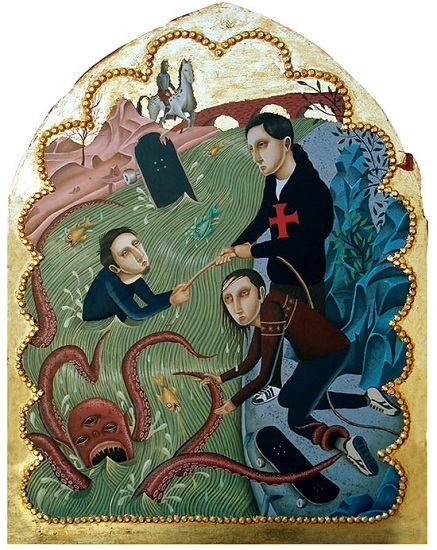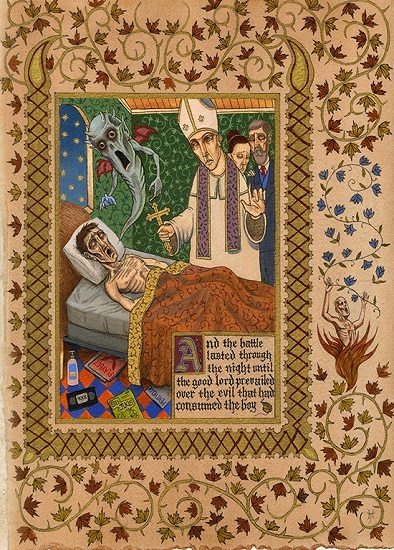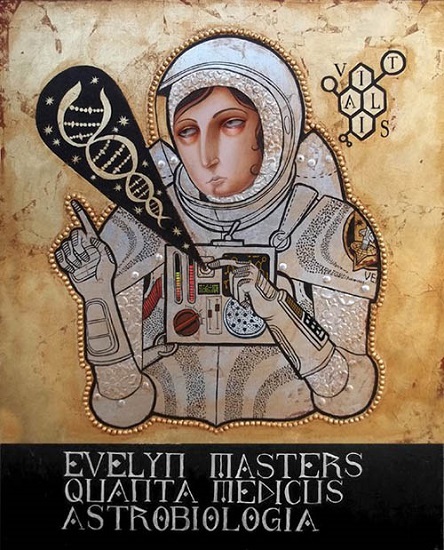Often when we do art, we tap into a historical narrative that influences our current perspective. This could be done in several ways such as examining economic principles like primitive communism, feudalism and slave labor, or sometimes we assess ancestral roots to understand the trajectory of our bloodline in order to guide us in contemporary society. We sometimes look at previous art styles or entire cultural periods to inspire new works or design, or we read the classics, ancient philosophy and early religion to give us a framework from which to build upon. However, sometimes we look toward the future, hence the futurists, which often results in narratives related to new urbanism and the industrial metropolis, or a dystopian prison-like society where the Panoptican remains triumphant. Or maybe the complete opposite where we learn to co-exist without war, famine, violence, disease and so forth... in a utopian new world, in the aesthetic age. Recently I was walking through the Loyola Marymount University campus in Westchester, and I remembered how impressive the illuminated manuscripts of the Renaissance period were, including the glass-engraved iconography inside Catholic churches. I wondered if there was a contemporary artist that tapped into religious imagery to interpret a modern, secular urban society. And there was... here in Los Angeles, in my own backyard, Jason Hernandez.
Straight out of Bellflower, California, Hernandez grew up in a conservative Catholic household where as a child he was drawn to the church experience as an art laboratory. From the architecture, to the window panes, to the bible itself, the religious motifs would leave a lasting impression on the young artist who had already started winning art contests. One of the most astounding moments in his life was on Portfolio Day at the Cal Arts campus where he approached a booth where a professor, Gary Meyer, from the prestigious Art Center College of Design in Pasadena looked at his portfolio and said, "Finally... the first one all day!" which subsequently led to several small scholarships to study there where Hernandez received a BFA in illustration. There he learned to perfect his church-inspired illustrations from the 15th century along with his fascination with early Flemish works of the late gothic and Renaissance period. However, Jason Hernandez has not only been looking backward at mythological and metaphysical humanist ideals that birthed the Reformation and the Scientific Method, he has also looked forward as a result of the modern enlightenment of science. His deep appreciation for quantum physics and astronomy has allowed the marriage of science and religion in his work, which complements his art with utter superiority. After all, science and theology both looked towards the cosmos to understand existence and the supernatural realm.
In the above painting titled, Lifeline, Hernandez tells a factual story of a day when he was riding his skateboard along the Los Angeles River, lost control, and the board fell into the current which seemed to be getting devoured by whatever existed in the abyss. Without second-guessing, he immediately jumped into the river to save his mode of transportation, and thoughts of modern technological extensions of man such as the automobile, the armor, the sword, and the horse plagued his mind. In the background he saw a man galloping on a horse, since there are many horse stables along the L.A. River that remind us of a pastoral paradise, and he appeared like a knight-errant and threw in a lasso to save him. The current was strong, the water was polluted, and the inside was slimy, thus the savior appears like a heroic Knight Templar in an urban setting. Hernandez has the ability to paint real-life settings of excruciating pain and beauty simultaneously, often with blank expressions on the characters faces, that in actuality communicate entire epical journeys. Moreover, he often paints astronauts with their helmets on or by their side that depict halos of radiance. From his perspective, the astronaut will be remembered as the errant knight in the future with their armor and helmets, reminiscent of medieval gallantry, because they too will colonize distant lands.


